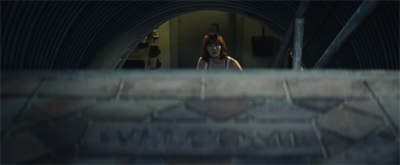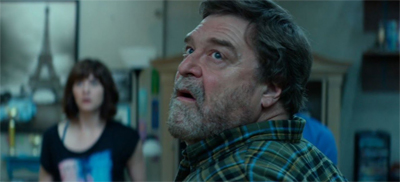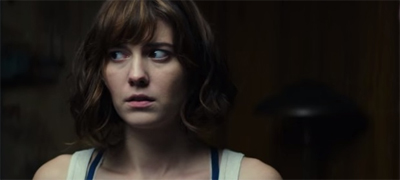10 Cloverfield Lane is a beautiful piece of speculative paranoid horror.
The plot follows Michelle, a young woman who is involved in a car crash. She wakes up to find herself in a strange concrete bunker, under the care of the mysterious (and more-than-slightly sinister) Howard. As she comes to her senses, Howard advises her that something horrible has happened; the world has ended outside and they are sealed safely inside an air-tight self-sustaining bunker. However, Michelle has a healthy degree of skepticism about Howard’s claims, wondering what exactly is going on and just how trustworthy Howard actually is.

At home at the end of the world.
Maybe.
To reveal any more would be to spoil the film. 10 Cloverfield Lane is very much a “mystery box” production, in keeping with various other JJ Abrams projects from Cloverfield to Super 8 to Star Trek Into Darkness. Although Abrams is not directing, 10 Cloverfield Lane retains a lot of the director’s aesthetic. It is a film that is designed to be seen with the bare minimum of information, to the point where the unveiling of the movie’s title came surprisingly late in the release process.
However, writers Drew Goddard and Daniel Casey (working from a story by Matthew Stuecken and Josh Campbell) and director Dan Trachtenberg use that mystery box structure in a manner distinct from Abrams’ blockbuster sensibilities. 10 Cloverfield Lane plays like a feature-length high-budget episode of The Twilight Zone, a story that looks and sounds great but would (mostly) lend itself to a stage play adaptation. 10 Cloverfield Lane feels very much like a classic high-concept science-fiction horror, in the best possible way.

Music to his ears…
There is something innately nostalgic about 10 Cloverfield Lane, both in the film’s structure and its content. The film retains the “Cloverfield” branding that Abrams’ applied to Matt Reeves’ found footage monster film, but the actual connection is tenuous at best. In an era where even Transformers and Rocky seem to generate the near mythic “shared universe”, the strongest connecting material between Cloverfield and 10 Cloverfield Lane is thematic at best. The films may as well be credited as “JJ Abrams presents…”
Abrams himself has likened the “Cloverfield” brand to something like The Twilight Zone, and that feels entirely appropriate. The connection is primarily external to the work itself, akin to an endorsement or anthology. It is an approach that seems incredibly outdated in a world where movie studios seem to plan their movie franchises three or four movies ahead, blocking out release dates half a decade into the future. 10 Cloverfield Lane harks back to something of a simpler time.

Duct and cover.
This retro sentiment is mirrored in the story itself. It spoils nothing to suggest that 10 Cloverfield Lane is a claustrophobic paranoid thriller about people stuck in a bunker together, unsure of who (or what) to trust. The film evokes classic red scare horror, in both themes and iconography. This is a movie where nobody can trust one another, where power dynamics serve to keep the players off balance. It is also set inside a bomb shelter during what one character claims to be the end of the world.
Although bomb shelters still exist, and are still built and maintained by survivalists, the bomb shelter setting harks back fifties atomic anxiety. It recalls an old world order, where the United States would actively encourage families to build such shelters to house survivors in the event of a nuclear attack. Howard is ambiguous about the nature of the attack in 10 Cloverfield Lane, non-committally suggesting that it could be “nuclear or chemical.” Of course, the fact that 10 Cloverfield Lane is ambiguous about the existence of an external threat is itself a very Twilight Zone touch.

“I’m not in Kansas any more. Or maybe I am in Kansas.”
Even within the bunker, 10 Cloverfield Lane evokes classic Americana. Howard keeps a juke box as a centrepiece of the room, while the group’s communal activities never involve anything more contemporary than boardgames or puzzles. “Home sweet home” reads a sign hanging in the communal area, while one of the movie’s more knowingly ironic touches is the familiar “welcome” mat placed just inside Howard’s makeshift airlock. Howard hosts dinner in a very old-fashioned way, gathered around a wooden table that is a “family heirloom.”
One of the delightful twists of 10 Cloverfield Lane is how it plays with this decidedly old-school iconography. After all, there has been no better time for a rival in classic fifties-style paranoid horror. This year has seen a United States presidential election where major (and viable) candidates have repeatedly and brutally engaged in xenophobia and Islamophobia. Donald Trump runs on the slogan “make America great again”, consciously appealing to a nostalgia for the simpler times and the “good old days” when there was a clearly polarised “us” and “them.”

It’s not all Goodman.
As such, the bunker feels like a metaphor particularly suited to 2016. It is a place where Howard can lock himself away from the world and cast himself in the role of stern (but loving, he’d argue) patriarch. At one point in the film, Howard suggests that he has seen his family eroded and destroyed; he recalls how his wife left him, taking their daughter with him. For Howard, the bunker and the potential apocalypse represent an opportunity to put things back to the way that they should be; to the way that he thinks they show be.
“This is the way it was always going to be,” he assures Michelle at one point in the story. Over the course of the film, he repeatedly and creepily infantalises Michelle. He insists on supervising her while she uses the bathroom. He dresses her in old clothes that belonged to his daughter. At one point, during a game of Taboo, he even refuses to acknowledge Michelle as a grown “woman”; asked to assign labels to his guest, he repeatedly attempts “girl” and “princess”, a clear indication of the dynamic as he sees it.

“Have you seen Room? No? Good, then this’ll all be new to you.”
Goddard and Casey’s script is written very much in the rich tradition of allegorical science-fiction and horror. Even the movie’s gags and set pieces are staged so as to suggest the metaphors and analogies bubbling just below the surface. The introductory sequence parallels Michelle’s painful break-up to the possible end of the world. The film’s final act has a great deal of fun stretching its metaphor like a rubber band, trying to see how far it can stretch the central themes before they snap. It turns out that there is considerable give.
It helps that 10 Cloverfield Lane has a sense of humour beneath all the mounting tension and creeping anxiety. Given that Howard’s bunker serves as a place of retreat from the wider world, one montage is ironically set to the Tommy James and the Shondells’ hit I Think We’re Alone Now; the chorus lyric “running just as fast as we can” plays over shots of characters doing idle tasks. There are moments when the script threats to strain the point too heavily; having characters talk about “running” and “freezing” feels a little on the nose. These moments are fleeting.

An outside chance.
It helps that 10 Cloverfield Lane has a strong central cast. Mary Elizabeth Winstead is one of the most reliable genre leads working today, doing an excellent job of portraying Michelle as a resourceful and intelligent protagonist. However, it is John Goodman who steals the show as Howard. If the “Cloverfield” brand promises a monster, then Goodman delivers. Goodman alternates between affecting and terrifying, his physical presence and voice more effective than any CGI monstrosity.
Dan Trachtenberg cleverly plays up to Goodman’s gravitas. Repeatedly over the course of the film, Howard is treated as a predatory stalking just around the corner. 10 Cloverfield Lane ensures that the audience hears Howard before we see him, the sound mixing allowing Howard to move through the underground bunker like a dinosaur. The environment seems to creak and strain at his presence, like those movie monsters who signpost their arrival by rustling in the corn or creaking on the wood. It is a delightful effective and unsettling touch.

(Mi)chelle shocked.
10 Cloverfield Lane is a powerful example and exploration of fifties nostalgia, one that manages to both revel in the iconography and recoil in the implications of that long gone era. Evoking the decade so effectively, and so critically, 10 Cloverfield Lane becomes a horror movie perfectly tailored to 2016.
Filed under: Non-Review Reviews | Tagged: 10 cloverfield lane, anthology, Cloverfield, donald trump, fifties, film, horror, Movie, non-review review, paranoia, review |




















It’s all so very fun and exciting. Even if the last-half is a bit wacky. Nice review Darren.
I adored the final fifteen minutes, if only because it feels like the kind of thing that you’d suggest in a story meeting only be shot down because there’s no way an audience would go with that. I’m surprised so many audiences seem to go along with. Personally, I adored it.
I’m not going to see the movie until Saturday, so I’m avoiding spoilers and only skimmed the second half of your review, but I’m strongly reminded (speaking of your “Twilight Zone” analogies) of the episode “One More Pallbearer”, in which Joseph (Dr. No) Wiseman plays a sadistic millionaire or something looking to taunt his mortal enemies with a spot in his own bomb shelter. At least, that’s how I dimly recall it… not the best known of TZ episodes.
I’ve been meaning to do a watch of my Twilight Zone blu rays. As you suggest, I’ve watched most of the “best known” episodes, but really haven’t dug properly into the series as a whole. As ever, it’s one of those “if I only had the time” things.
You write ridiculously awesome fucking reviews, Darren. This movie made me jump out of my seat, something a movie hasn’t inclined me to do before, and my heart fluttered in anticipation until the reveal of the external threat. I haven’t been terrified in a theater experience before in a very long time, and I loved every damned minute of it. This and the original Cloverfield have been two of my favorite film experiences of my life. And John Goodman, he better win an award for that character.
Thanks Elton!
Goodman is amazing, isn’t he? It’s a great film.
OK, now have seen the movie proper. Your Trump metaphor may be a bit strained — the first draft of this script was written years ago, as it turns out, and the movie itself (at least, up until Goodman’s beard-free obvious reshoot in the final reel) was filmed in 2014, before Trump had ascended to where he is now.
However, the rest of your take is spot on. I also enjoyed the other sardonic soundtrack choice (“Tell Him”, by The Exciters, previously heard on the “Big Chill” soundtrack), too. “Tell him that you’re never gonna leave him”.
Excellent movie. I saw this in a packed theater in Manhattan, with the audience audibly gasping at every twist and turn, and with everyone that I spoke to on the way out, having had their minds fairly blown.
It’s a fair point about the strained metaphor. But I do think that Trump is a symptom of something in the collective consciousness; there is a strong pull towards nativism that I think feeds stories like this. Although it never managed the same popular appeal, the Tea Party was very much part of the same “let’s set things back to the way they should be” sweep in popular politics.
10 Cloverfield Lane is a great film to see with an audience. I had the exact same experience at a packed cinema in Dublin. The audience was really into it. Even the bit that I was worried would be too “out there”, literally and figuratively.